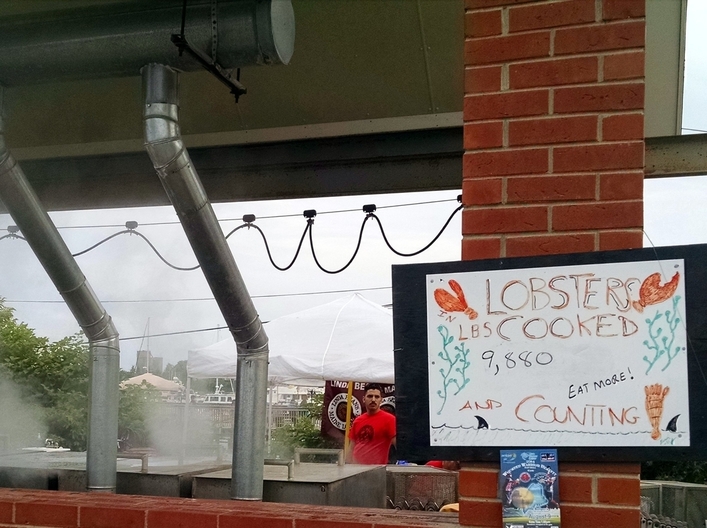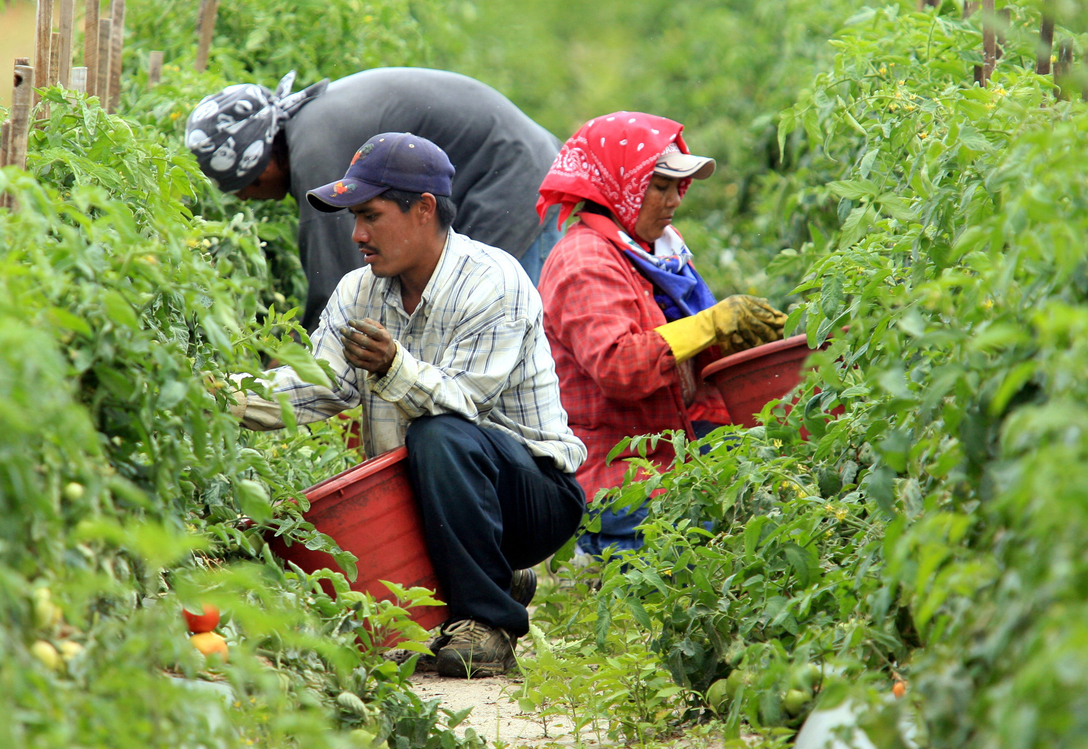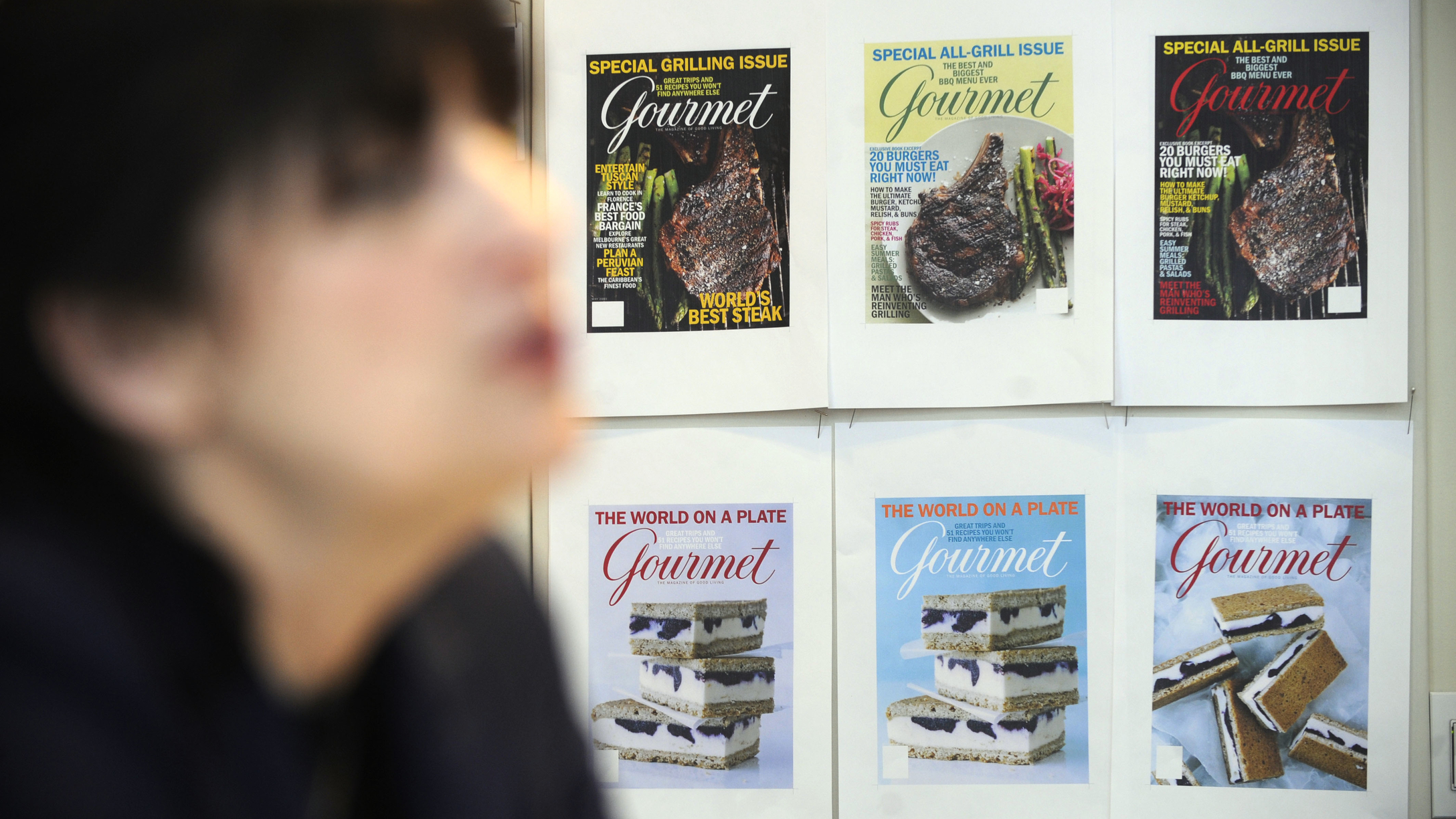In 2003, the novelist David Foster Wallace spent a weekend in Rockland, Maine, reporting a story for Gourmet Magazine about the Maine Lobster Festival. The kitschy summer affair, held annually in what was then still very much a fishing town with plenty of rough edges, grants attendees the opportunity to eat a near-endless amount of lobster in a near-endless number of preparations, from rolls and chowder to mac-and-cheese and tacos.
Held in Harbor Park, a grassy slope overlooking the town wharf, the festival is conveniently located next to the waters where the bulk of American lobster is caught. “Part of the overall spectacle of the Maine Lobster Festival,” Wallace wrote, “is that you can see actual lobstermen’s vessels docking at the wharves along the northeast ground and unloading freshly caught product, which is transferred by hand or cart 100 yards to the great clear tanks stacked up around the Festival’s cooker—which is, as mentioned, billed as the World’s Largest Lobster Cooker,” capable of boiling up 100 lobsters at a time.

The assignment was an open-ended one—go to this festival and write about what you see—so it was something of a surprise when Wallace filed more than 7,000 words centered on that cooker. It’s there that Wallace lingers, famously considering just what, exactly, happens when a crustacean is plunged into 212-degree water: “Is it all right to boil a sentient creature alive just for our gustatory pleasure? A related set of concerns: Is the previous question irksomely PC or sentimental? What does ‘all right’ even mean in this context? Is it all just a matter of individual choice?”
In classic Wallace fashion, the piece is full of discursive footnotes on topics like tourism, class, and the unattainable nature of true “local flavor” that, as he wrote, will “almost surely not survive magazine-editing.” While that footnote and others did make it through edits, the whole piece barely survived. Wallace threatened to pull the story during a contentious and highly negotiated editing process. According to Jocelyn Zuckerman, who assigned the story, there were debates over the placement of colons and the overarching question of “how many people we were going to piss off.”
Eventually, Ruth Reichl, the magazine’s longtime editor in chief, told Wallace that he could take the piece elsewhere if he wanted to. Anyone would publish the essay—The New Yorker, The Atlantic, Harper’s—but, she told him, “Consider the Lobster” didn’t belong in such a magazine. “You want cooks to be reading it,” Reichl recalled telling him. “You want people who are cooking the lobsters to read it.”
In the end, Wallace relented, and “Consider the Lobster” ran in Gourmet. In the story, he openly doubts that crustaceans’ experience of pain was much of a concern to an audience of cooks: “It appears to me unlikely that many readers of Gourmet wish to think hard about it, either, or to be queried about the morality of their eating habits in the pages of a culinary monthly.”
The alert reader of Gourmet would already have known that Reichl wanted to ask those questions. During the 10 years that she ran the magazine, from 1999 until Condé Nast shuttered it in 2009, the polite yet firmly confrontational style found in “Consider the Lobster” defined Reichl’s editorial approach. But the tumultuous editing that brought Wallace’s polemic to a lifestyle magazine shows how delicate a balance was required of Gourmet. You could piss some people off, but not everybody.
The 2004 issue “Consider the Lobster” appeared in featured a jar of homemade jam on the cover and included a story asking whether expensive Riedel glassware makes any difference in how wine tastes. Flipping through another 2004 Gourmet, June’s The Grill Issue, you’re looking at a recipe for soba salad with carrot and zucchini, “and you’re reading that Procter and Gamble knew for 30 years that trans fats were terrible,” Reichl told me recently. Or you’re reading about the culinary wonders of Spain’s remote Extremadura region and then learning, in vivid detail, about the modern-day slaves being exploited by Florida tomato growers. Reading such stories in a glossy food magazine rather than, say, the New York Times? “It’s a very different experience,” she said. Rather than finding culinary hedonism in one section of the paper and cold facts about the business of food in another, Gourmet readers were seduced by food on one page and then confronted by the uncomfortable realities of their food on the next.
Many magazines, and food titles in particular, operate on the premise that the editors know what readers want and give it to them over and over and over again. But as James Truman, the former editorial director at Condé, told Reich when she was hired: “I came to you thinking I wanted an elegant dinner party, but I realize that I wanted so much more.” At Gourmet, Reichl took an established audience and stopped giving them familiar stories about fine dining in European capitals and the rustic cooking of the provinces, and instead tried to bring them somewhere they hadn’t known they wanted to go.
As a publication that began its life with offices in the Plaza Hotel and published under the tagline “the magazine of good living” for nearly seven decades, Gourmet was never going to be accused of being radical. The grand political gesture of the debut issue, published in January 1941, was to not feature a single woman in the entire magazine—a blunt rebuke of the very housewife-centric editorial and advertising approach taken by magazines like Good Housekeeping and Woman’s Day. Men continued to dominate the bylines at Gourmet in the post-war years, with Samuel Chamberlain documenting the meals he ate on a seemingly endless jaunt across Europe, or Robert P. Tristram Coffin lamenting the loss of the taste of his rural New England childhood: bird stew made with wild plover, heron, or marsh hen before such aquatic species were protected.
The magazine was ultimately shaped both by the women who read it and the ones who ran it—four out of Gourmet’s five editors in chief were women. The publication came to stand for a very particular sensibility: never aspirational, always inclusive. Occasionally this inclusiveness could stretch the imagination, but even a story suggesting that you jet off to Alba to eat white truffles was presented as an utterly relatable experience—the kind of thing Gourmet readers not only could do, but would do, next fall, when white truffles were back in season. Gourmet’s true concern was with “chronicling the lifestyle of people who are wealthy—not necessarily famous, but wealthy,” Helen Rosner, food correspondent at the New Yorker, told me. A long feature about where to buy leather gloves in Madrid, from a 1990 issue, does not present the trip as fantasy—“When I said ‘buffed pigskin, lined, size size 7½, black, please,’ just watching the proprietor reach for the correct drawer in a wall of glove drawers was part of the pleasure of buying”—but, as Rosner explained, a simple, entirely factual reality; the reader would already know her own glove size, too, as a matter of course.
While Gourmet had perfected coverage of conspicuous consumption of the upper-upper-middle class, by the late ’90s, the editorial process had become rote. Assignments were made from the top down, affording little room for creativity, with the mix of stories in each issue following a rigid template. The magazine was, Reichl said, “prissy” and “a bore.” “It had maybe been getting a little ossified,” said Jane Lear, who spent nearly 19 years working at the magazine.

Reichl, who dates her early interest in food to the time she spent in Berkeley in the early 1970s, brought a California sensibility to the magazine—a love of fresh produce and social justice—and gave her editors exceptional autonomy. Supplied with a massive budget and a long leash, Lear, Zuckerman, and others looked to writers who could both find and tell a great story—even if it had only a tenuous connection to food. In Reichl’s Gourmet, Michael Ruhlman described not only the flavor of the rabbit cooked by Thomas Keller at The French Laundry, but the scream the animals made when the chef killed them. Michael Pollan wrote about Joel Salatin, the quixotic, straw-hat-wearing Virginia farmer profiled in his eventual bestseller, The Omnivore’s Dilemma. Chimamanda Ngozi Adichie wrote about spicy chilies and the role they played in stamping out the emerging sexuality of young Nigerian women. Francis Lam wrote about Jackie Wong, an obscure Chinese cook who perfected barbecue pork at his Toronto restaurant only to determine that the skill would die with him—he didn’t want his Chinese-Canadian children to live a life as hard as his.
It wasn’t that these kinds of stories were invented at Gourmet—Reichl had published plenty of them herself at the Los Angeles Times, where she was the restaurant editor and then critic in the 1980s and ’90s, working alongside Jonathan Gold and Laurie Ochoa (Reichl’s first deputy editor at Gourmet, who is married to Gold). But prior to her taking over the magazine, “serious” food journalism had been the domain of “serious” publications like the New Yorker or the Atlantic. “You’d never find it in a major food magazine,” said Barry Estabrook, who was a contributing editor at Gourmet. “It was completely ignored.” Reichl was one of the first editors to bring substantive reporting on food into a glossy lifestyle magazine, locating Gourmet’s primary subject at the heady overlap between trade, commerce, public health, the environment, identity, and culture. It’s what made Reichl’s Gourmet so compelling—and contributed to its ultimate demise.
Reichl didn’t set any kind of quota for political stories, but there tended to be one or so per issue. “You don’t want to be Mother Jones,” she said of her editorial approach. “You do it judiciously, you package it in with gorgeous recipes and wonderful writing, and you can really change people’s minds.” The 2009 issue that included Barry Estabrook’s reporting on slavery in Florida’s tomato fields had a Cuban sandwich on the cover. Inside, there was a recipe for a Provençal chicken-and-tomato roast for two. Considering that nearly all domestic fresh tomatoes available at the grocery store in March, when the story ran, come from Florida, it could seem trite or contradictory to publish a recipe featuring fresh tomatoes alongside a story that says such tomatoes may have been picked by slaves. At Gourmet, such contrasts were deliberate.

The range of facts Gourmet concerned itself with wasn’t limited to the social or environmental footprint of a food. Under Reichl’s direction, the magazine became about knowing everything about food. “Gourmet recognized the incredible value, social and cultural value, that existed in tiny details. Like going to buy a glove, or using Oaxacan honey instead of bear-bottle honey,” says Rosner. It wasn’t enough to know how to cook a chicken. You had to know how to cook it perfectly and understand the science behind the cooking method—and also know the breed of the bird, the conditions it was raised in, and the effects of such a rearing upon the surrounding environment.
The same approach applied to issues of culture, race, and gender as they related to food. Though Gourmet had a wealth of female perspectives, especially among its editors, the same cannot be said for matters of race, as the staff was largely white. But the magazine did make strides in reporting on minority communities. As Reichl said of the 2007 Latin issue, which explored food culture across the Spanish-speaking world, “We got people to write about their own communities in ways that I don’t think had been done before.”
When he was writing about Jackie Wong, the master of Chinese barbecue pork, Francis Lam said, the story became very political for him. “When I say ‘political,’ I mean literally about policy and politics, but also: Are we humanizing invisible people?” To give a face and voice to an immigrant character like Wong, and to humanize both his experience and that of his first-generation children, was powerful for a Chinese-American journalist like Lam to write, and for an audience to read. Lam said he saw this kind of humanizing politics as it relates to race as an opportunity to ask, “How able are we to see one another, and to see invisible people, and how do we negotiate that?”
Such gestures toward inclusion marked progress, but they were hampered by the magazine’s own audience in two significant ways. The magazine assumed that its audience was rich and white in the 1990s, an assumption that persisted during the Reichl era. The diversity on the page was not mirrored in the reader. And then there were the ways readers rejected that humanizing vision. Reichl said that there wasn’t a political moment in the Latin issue (in the partisan sense of the word), but Gourmet still received numerous letters demanding that the staff keep their politics out of the magazine. To those readers, even discussing immigrants in a positive light was political.
Like all high-end lifestyle publications, Gourmet relied on luxury advertisers. The kind of editorial budget that earned contributors $3 a word and up, and gave staff perks like the freedom to take any cooking classes they desired on the company dime, was part of what enabled Gourmet to produce the journalism that it did during Reichl’s era. But it’s easier to convince advertisers to spend their money with Gourmet instead of another food magazine when their ads are running next to a story about lobster rolls instead of lobster death.
The conflict between ad sales and an expansive editorial vision is nothing new in magazines. Reichl had long dealt with angry grocery stores that paid the Los Angeles Times to stuff its food section full of coupons (which represented a major chunk of the $34 million in revenue the section pulled in annually). When she helped revamp the paper’s food coverage in 1990, and began running stories about Chinese grocery stores and Salvadoran home cooking, “the supermarkets were so furious that I wasn’t running recipes for their canned foods, and they demanded that the paper do something about it,” Reichl said. But it came out during focus groups, held at the behest of the grocery stores, that female readers didn’t want to read about organizing coupons—they wanted to know what their neighbors were eating, or what it was like to cook on a food-stamp budget.
The economic picture was different in 2008, when advertising dollars began to dry up across publishing. In the face of the Great Recession, the paid circulation of 1 million readers that Gourmet enjoyed was probably not as compelling of a business prospect when the recipe-centric Bon Appétit was less likely to generate phone calls from big airline, cruise ship, and meat industry advertisers. As Estabrook said, “I don’t know how many expensive watches or nice cars you sell based on stories about slaves in tomato fields.”
Nearly all of the former Gourmet staff that I spoke with lamented the fact that the kind of food writing the magazine championed has once again become the realm of magazines like the New Yorker. “I hate food being pulled back into this very narrow place,” Reichl said. “That’s what Bon Appétit is going after: the trendiness.” Adam Rapoport, who was named Bon Appétit’s editor in chief at the time of Gourmet’s closure, showed little inclination to pick up where Reichl had left off. As Julia Moskin wrote in the New York Times in 2010, “He does not see education as the magazine’s primary role.”
New food magazines have come and gone, and others have pivoted or been revamped, but the space once occupied by Gourmet on the newsstand remains empty.
Food journalism—like all journalism—is no longer the realm of magazines and newspapers alone. The recipe blogs of the early 2000s have given way to full-blown publications with ambitions not just to cook recipes from Gourmet, but to pursue similarly deeply reported journalism. Today, there are food publications with niche concerns, ranging from environmental issues at Civil Eats to breakfast at Extra Crispy—where you’re just as likely to discover a new way to cook eggs as learn about the act of LGBTQ solidarity that was the 1977 Florida orange juice boycott.
Videos of trendy rainbow bagels and pizza porn are proof enough that digital food outlets also publish plenty of clickbait garbage. But in the past few years, online publications have proven more ready to respond to the social and political environment of the moment, and have often taken the lead from food magazines in reporting on beats like immigration, diversity, and sexual assault as they pertain to the food world. Eater, which has grown from a rumor-mill blog to one of the best-reported food websites over the past 10 years, was the first to break the news of sexual abuse allegations against restaurateur Mario Batali—which was followed by additional reporting in the New York Times. The website Taste Cooking regularly features the voices of non-white food writers. Even the food newsletter Tasting Table (where I covered new restaurants and food and drink trends between 2010 and 2012) recently ran a post with the headline “Julia Child’s Advice for Dealing with Sexual Harassment”—a far cry from what it was publishing five or six years ago.
But as I asked colleagues in food journalism about their memories of Gourmet, and how they see its legacy and influence, I was surprised by how many of them had no real opinion at all—even people in their early to mid-30s, many of whom were out of school and starting their careers when the magazine folded.
That’s around the time Wyatt Williams, dining critic at Atlanta’s AJC, started to get interested in the conversation around food. “It was only later,” he said, “that I found out that half the reasons I cared about that food conversation at all were directly shaped by the stories Ruth Reichl was assigning and editing at Gourmet.”
Maybe a legacy of influence, recognized or not, is the best thing Gourmet can offer us. “Maybe Gourmet would suck now,” Rosner says jokingly. “Maybe it was a mercy that it died at the peak of its glory days.”
Long live Gourmet. Gourmet, RIP.






